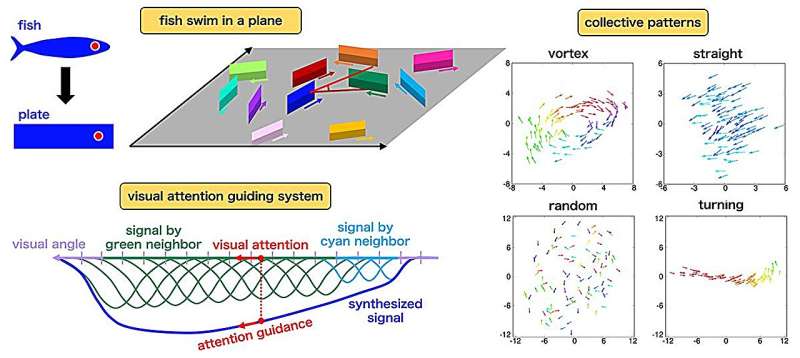This article has been reviewed according to Science X's editorial process and policies. Editors have highlighted the following attributes while ensuring the content's credibility:
fact-checked
peer-reviewed publication
trusted source
proofread
Simulations reveal mechanism behind dynamic fish schooling

Schools of fish are able to pull off complex, coordinated maneuvers without ever colliding with one another. They move in unison but don't follow a leader.
To try and understand the intricacies of this collective animal behavior, researchers from Tohoku University have developed a model that simulates the group motion of fish based on visual cues. Incorporating the tendency that fish focus on nearby, quickly moving fish, the model uncovers the mechanism behind dynamic fish schooling.
The research is published in the journal PNAS Nexus.
"Fish have a wide angle of view and can detect many other fish in a school," explains Susumu Ito, "However, a recent experimental finding shows that each fish selects a single fish from a few targets and traces its motion. It is a spectacular example of selective decision making."
Attending to every single fish in the school would require an immense amount of information to be processed. Similar to how we can focus on just the words we are reading on a page of text, fish can focus on the most salient target that determines their next move. While the fish swimming directly in front may seem like the best option, it's actually fish that are slightly to the sides that tend to draw attention.
Ito and his team constructed a model that takes visual attention into account to elucidate the role of selective visual interaction in a large group of fish. It incorporates the feature of retinal ganglion cells that fire preferentially for targets that are closer and moving more quickly. Visual attention is then guided in the direction of the strongest signal. Only fish that fall within that spotlight of visual attention can influence the motion of the individual fish.
Using numerical simulations, the team of researchers found that when a fish is following three targets swimming in a row, it tends to be attracted to the leftward or rightward target, as they have a larger apparent size. A slender fish facing straight ahead viewed directly from behind will look much smaller than a fish exposing its longer profile. These results replicate the selective tracking motion seen in previous experiments.
Furthermore, the model reproduced various collective patterns of fish schools: a rotating vortex, straight, random and turning. In the turning pattern, fish repeatedly alternate between straight and rotating motion, so that the school dynamically reshapes itself.
"The selective tracking behavior is observed also in locust and fly," adds Ito. "We expect to extend the model to the group motion of various organisms in the future. A three-dimensional version of the model may also be able to explain the formation of a huge fishschool known as the bait-ball."
More information: Susumu Ito et al, Selective decision making and collective behavior of fish by the motion of visual attention, PNAS Nexus (2024). DOI: 10.1093/pnasnexus/pgae264
Journal information: PNAS Nexus
Provided by Tohoku University


















